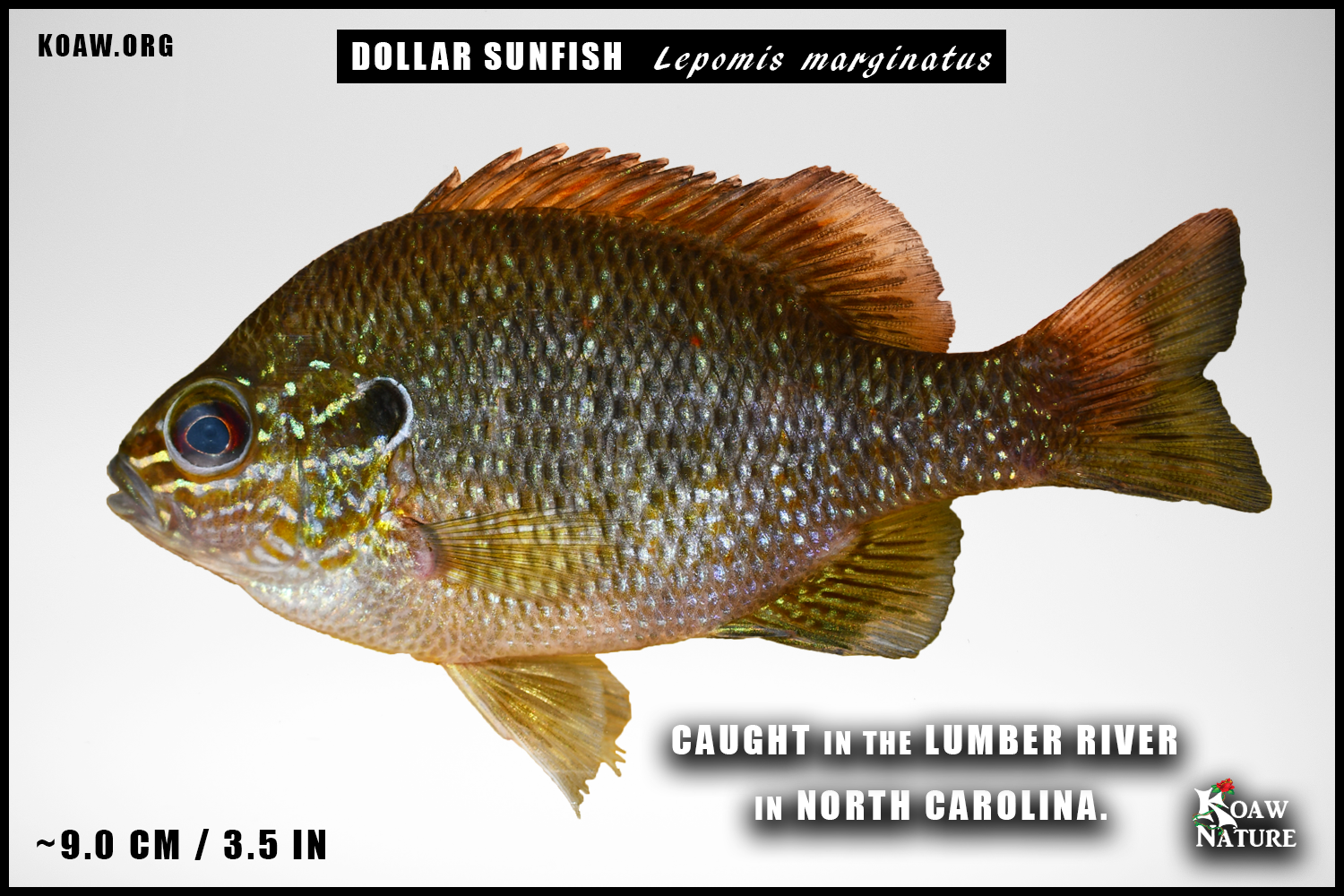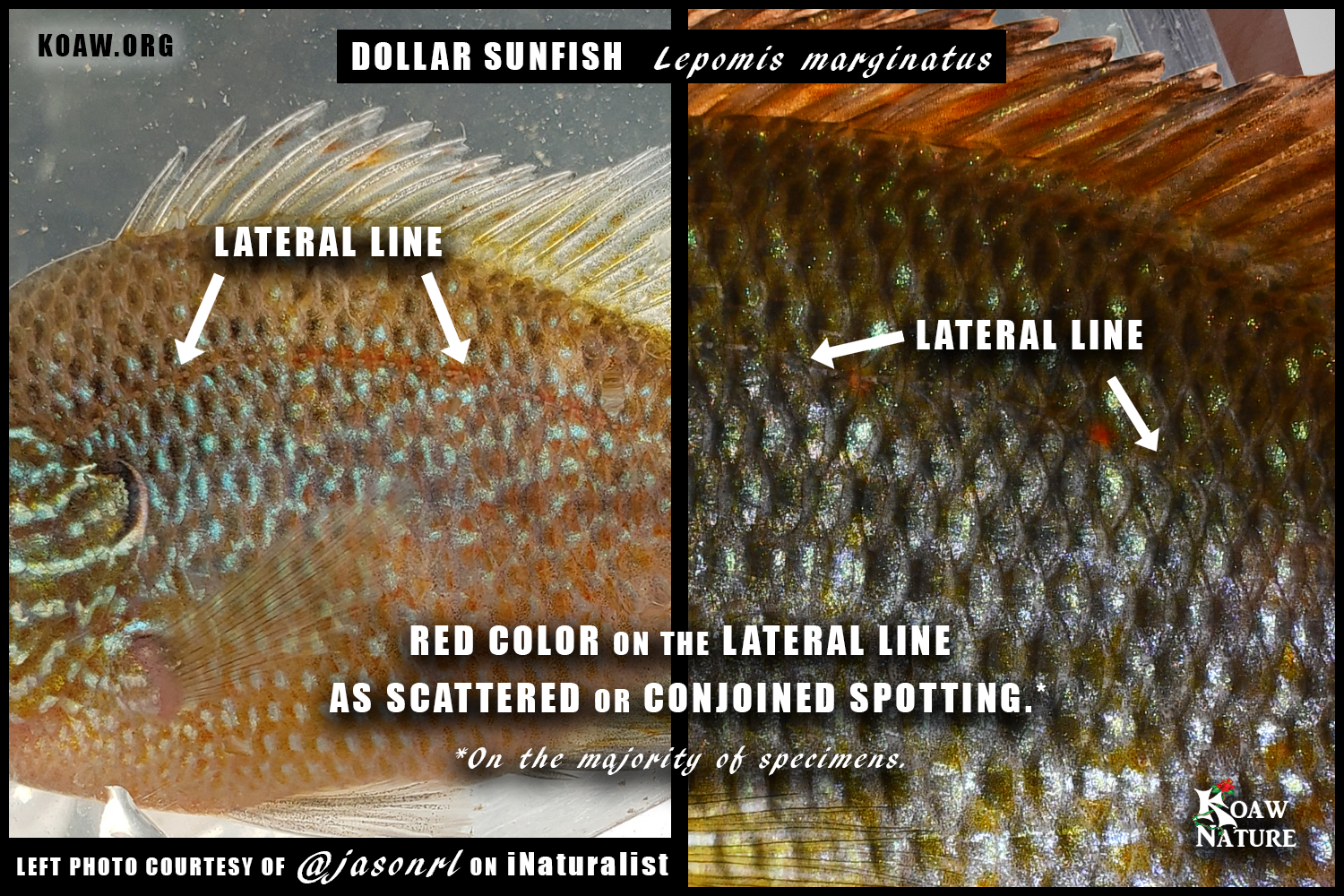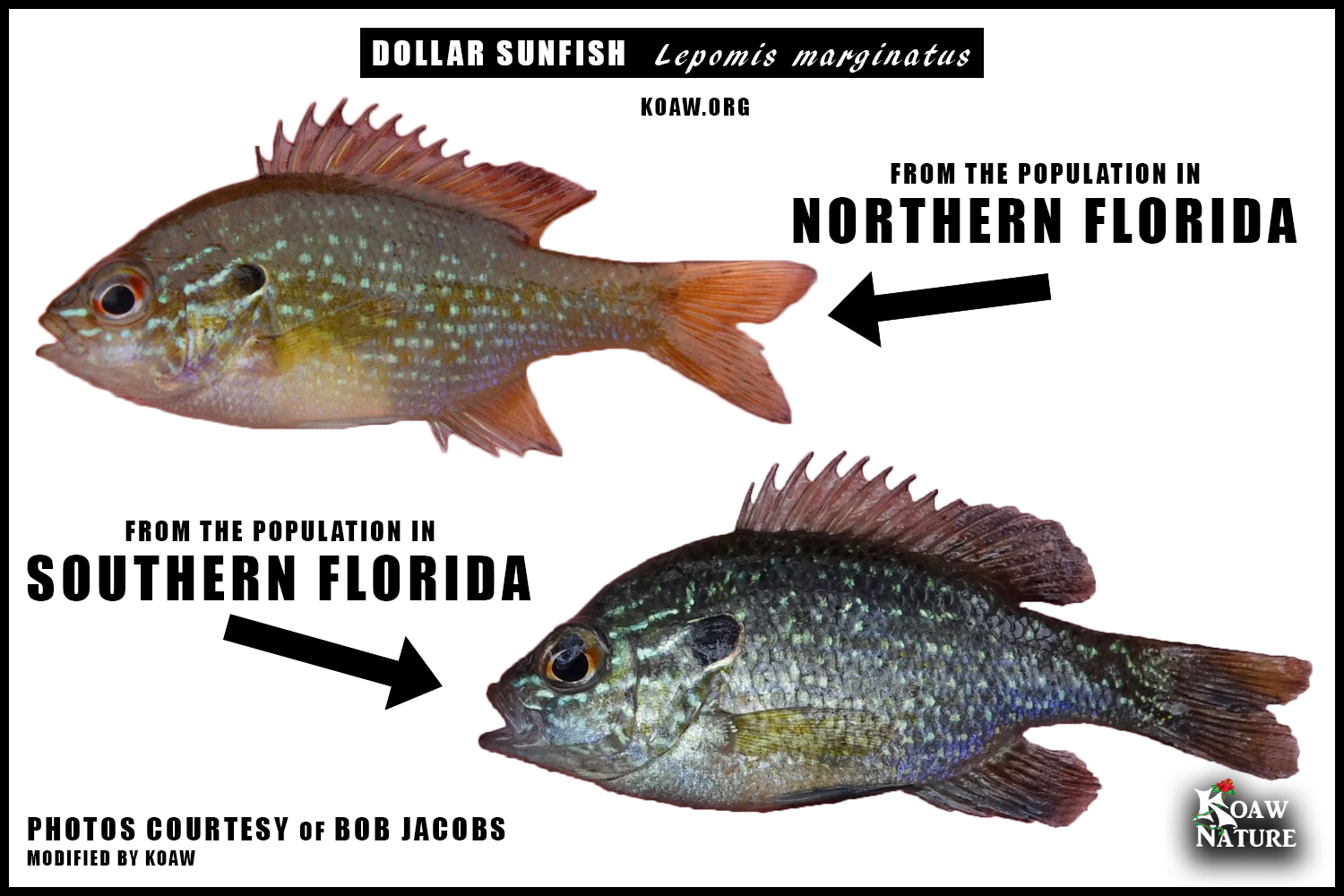By Koaw - November, 2020
GENERAL: The dollar sunfish (Lepomis marginatus - Holbrook, 1855) is a small and colorful species of sunfish. Some key features to use in identification: Look for red in the lateral line, 12 pectoral rays and markings on the opercular flap that are bluish green to silvery.
The smaller dollar sunfish is often confused with the longear sunfish (Lepomis megalotis); (see “SIMILAR SPECIES” below). A recent publication about sunfishes in North Carolina shed light on the misidentification of numerous dollar sunfish and redbreast sunfish (Lepomis auritus) as longear sunfish (Lepomis megalotis) going back over 150 years; the study strongly suggests that no longear sunfish were ever indigenous in the state of North Carolina and no known current populations exist today.[1]
BODY: The dollar sunfish is one of the smaller lepomids, usually not exceeding 12 cm (5 in) in total length. The body is laterally compressed and deep. The lateral line is complete with between 34-44 lateral scales. [2]
COLORATION: This species exhibits quite a bit of variance in coloration both seasonally and between populations. The blue/green spotting will always be present along the body on mature specimens that extends down to the breast and belly. Breeding males exhibit the most vibrant colorations with very pronounced blue spots on a dark red topside and a deep yellow/orange to dark red breast and belly. Other mature specimens may retain a dark olive color dorsally on the body and have a breast that is orange, yellow or a very pale yellow. The median fins are often mostly clear with red/orange running along the spines and rays with traces of iridescent blue and green.
Juveniles will be more olive colored dorsally with sparser spotting along the body and an almost white belly.
Dollar sunfish in the most southeastern part of the range may have black spots on the upper body; (E.g. Florida.)
The upper lip has blue streaking/blotches that usually does not extend across the entirety of the lip, of which, is unlike the longear sunfish (Lepomis megalotis) where the streaking along the upper lip meets from one lateral end to the other.
Quite often there is red on the lateral line, of which, may completely run along the lateral line or only exist on a few scales; sometimes the red is completely absent from the lateral line. Also look for bluish green to silvery markings on the black portion of the opercular flap. When distinguishing dollar from longear, if there is red on the lateral line and markings on the opercular flap then that almost definitely suggests it is a dollar sunfish and not a longear.
SIZE: To 12 cm (4.75 in). [2] This species does not get very large compared to most other species in Lepomis.
OPERCULAR FLAP: The “ear flap” is often pointed upwardly and the size may be short or moderate in length, usually not being much longer than the length of the eye. The edging is often pale and often possesses some faint color such as red and purple.
Notice the pale edging on the lower ear flap in the supporting image is nearly transparent on the back edge, of which, is not typical but does occur. Keep in mind that sunfishes can change their colors quickly and this includes the edging on the opercular flap.
Often the black portion of the opercular flap will have conspicuous bluish green to silvery markings, though not every specimen possesses these marks.
GILL RAKERS: The gill rakers on the 1st gill arch are knob-like, being very short and thick. These can be examined by gently lifting the gill plate and looking at the white portion above the red filaments on the gill arch closest to the gill plate.
I made a video describing how to locate and find these rakers that is hosted on Koaw Nature’s Fishing Smarts YouTube channel.
MOUTH SIZE: The mouth is moderately-sized for a lepomid. The jaw will typically meet or be near in alignment with the front of the eye’s pupil.
More specifically, the maxilla’s most posterior edge will be near or slightly past the anterior edge of the pupil (as the fish’s mouth is closed or nearly closed.)
PECTORAL FIN: The dollar sunfish typically has a moderately sized and rounded pectoral fin. Often there are 12 pectoral rays, sometimes 13 or 11. [2]
If bent forward the pectoral fin usually aligns near the front of the eye. It is not uncommon for the pectoral fin to be shorter, even aligning near the middle of the pupil if bent forward.
The pectoral fin, proportional to the body, is shorter than that of a pumpkinseed (Lepomis gibbosus) but longer than that of a green sunfish (Lepomis cyanellus).
HABITAT: Dollar sunfish can be found in swamps, creeks and moderate to small rivers as well as lakes. In creeks and rivers find dollar sunfish in calm waters and pools. Areas with cover, especially fallen trees, are prime habitat for this species.
Present in isolated wetlands in the Upper Coastal Plain in South Carolina in areas with infrequent drying. [3]
CLICK TO ENLARGE - This distribution map is an illustrated approximation created by Koaw primarily pulling data and information from USGS-NAS, Research Grade observations from iNaturalist and Page & Burr’s Field Guide to Freshwater Fishes.
LOCATION: The dollar sunfish is present only in the southern parts of the United States with more abundance in the southeastern part of its range.
Along the East Coast, populations start in North Carolina extending south all the way to Florida within the South Atlantic-Gulf Basin. Northern Georgia and the western parts of South Carolina have populations only along the Savannah River.
The Mississippi River Basin and Arkansas Red-White Basin have dollar sunfish populations starting in Missouri and Kentucky and extending southerly. The Texas Gulf Coast Basin also has populations of dollar sunfish. [2] [4]
FISHING: Get your small gear ready! Capturing these specimens required using size 12 hooks or smaller; bead-head flies, ant-mimics and poppers all received hits. Though I did have a nice specimen caught on the Lumber River in North Carolina on a fat chartreuse spider-mimic fly with a size 10 hook.
If it’s not breeding season and you can’t find ‘em on their nests then find the nearest cover such as fallen branches and vegetation. I witnessed a number of these specimens in North Carolina and Missouri hiding under fallen logs and branches only to be seen once they darted out after a passing lure. (I confirmed this behavior with my GoPro by sticking it in the water and seeing up to four specimens hiding under the same log; see the adjacent photo.)
Cut worms on small hooks will work well for this species too.
SIMILAR SPECIES:
REFERENCES:
B. H. Tracy, F. C. Rohde and G. M. Hogue, ""Ghost Sightings" Made by Ichthyologists Past: Longear Sunfish, Lepomis megalotis, in North Carolina," SOUTHEASTERN NATURALIST, vol. 19, no. 2, pp. 297-307, 2020.
L. M. Page and B. M. Burr, Peterson Field Guide to Freshwater Fishes, Houghton Mifflin Harcourt Publishing Company, 2011.
J. W. Snodgrass, A. L. Bryan, R. F. Lide and G. M. Smith, "Factors affecting the occurrence and structure of fish assemblages in isolated wetlands of the upper coastal plain, U.S.A.," Canadian Journal of Fisheries and Aquatic Sciences, vol. 53, no. 2, 1996.
iNaturalist, "iNaturalist Lepomis marginatus Dollar Sunfish," [Online]. Available: https://www.inaturalist.org/taxa/104254-Lepomis-marginatus. [Accessed October 2020].



